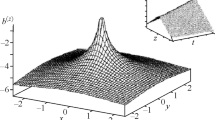Abstract
A conceptual substantiation of the necessity to consider the nanoscale structural level of plastic strain in the physics of plasticity and strength of solids is presented. It is inferred that the fundamental mechanism of plastic strain is represented by local structural transformations (of the type of rearrangement of atomic clusters of various configurations) that occur in a loaded solid in local zones of tensile normal stresses. This mechanism determines generality of the nature of all possible kinds of plastic deformation of solids.
Similar content being viewed by others
References
V. E. Panin (ed.), Physical Mesomechanics and Computer-Aided Design of Materials [in Russian], Vol. 1, Nauka, Novosibirsk (1995).
V. E. Panin (ed.), Physical Mesomechanics of Heterogeneous Media and Computer-Aided Design of Materials, Cambridge Interscience Publishing, Cambridge (1998).
V. E. Panin, “Synergetic principles of physical mesomechanics,” Theor. Appl. Fracture Mech., 37(1–3), 261–298 (2001).
A. Zangwill, Physics of Surfaces, Cambridge University Press, Cambridge (1988).
V. E. Panin, “Physical mesomechanics of surface layers of solids,” Fiz. Mesomekh., 2(6), 5–23 (1999).
V. E. Panin, “Surface layers of solids as synergetic activators of plastic yielding of loaded solids,” Metalloved. Term. Obrab. Met., No. 7, 62–68 (2005).
V. E. Panin and L. E. Panin, “Scale levels of homeostasis in deformed solid,” Fiz. Mesomekh., 7(4), 5–23 (2004).
A. Di Carlo, Actual Surfaces Versus Virtual Cuts. Whence the Boundary Conditions in Modern Continuum Physics? Roma Accademia Nazional dei Lincei (2004), pp. 97–113.
V. S. Demidenko, N. L. Zaitsev, T. V. Menshikova, and L. F. Skorentsev, “Precursor of virtual β-phase in the electron structure of nanocluster in α-titanium,” Fiz. Mesomekh., 9(3), 55–60 (2006).
A. V. Panin, “Nonlinear waves of localized plastic flow in nanostructured surface layers of solids and in thin films,” Fiz. Mesomekh., 8(3), 5–17 (2005).
V. E. Panin, E. F. Dudarev, and L. S. Bushnev, Structure and Mechanical Properties of Substitutional Solid Solution [in Russian], Metallurgiya, Moscow (1971).
V. E. Panin, V. M. Fomin, and V. M. Titov, “Physical principles of mesomechanics of surface layers and internal interfaces in deformed solid,” Fiz. Mesomekh., 6(2), 5–14 (2003).
Yu. V. Grinyaev and V. E. Panin, “Design of stress state in elastically loaded polycrystal,” Izv. Vuzov, Fizika, No. 12, 95–101 (1978).
V. E. Panin, V. S. Pleshanov, Yu. V. Grinyaev, and S. A. Kobzeva, “Formation of periodic mesoband structures due to stretching of polycrystals with extended interfaces,” PMTF, 39(4), 141–147 (1998).
G. P. Cherepanov, “On the theory of thermal stresses in a thin bonding layer,” J. Appl. Phys., 78, 6826–6832 (1995).
D. D. Moiseenko, P. V. Maksimov, and I. A. Solov’ev, “Stochastic approach to multilevel simulation of perturbations on interfaces in a loaded solid,” Fiz. Mesomekh., 7(2), 19–24 (2004).
D. D. Moiseenko and P. V. Maksimov, “Stress and strain distribution on the ’surface layer-substrate’ interface,” Fiz. Mesomekh., 8(6), 89–96 (2005).
V. E. Egorushkin, “Dynamics of plastic strain. Waves of localized plastic strain in solids,” in: V. E. Panin (ed.), Physical Mesomechanics and Computer-Aided Design of Materials [in Russian], Nauka, Novosibirsk (1995), pp. 50–77.
L. B. Zuev and V. I. Danilov, “Slow wave processes in deformation of solid bodies,” Fiz. Mesomekh., 6(1), 75–94 (2003).
E. E. Deryugin, V. E. Panin, Z. Schmauder, and I. V. Storozhenko, “Effects of strain localization in an Al-base composite with inclusions of Al2O3,” Fiz. Mesomekh., 4(3), 35–47 (2001).
V. E. Panin, and S. V. Panin, “Mesoscale levels of plastic strain in aluminum polycrystals,” Ivz. Vuzov, Fizika, 40(1), 31–39 (1997).
V. E. Panin and A. V. Panin, “Effect of surface layer in deformed solid,” Fiz. Mesomekh., 8(5), 7–15 (2005).
V. P. Alekhin, The Physics of Strength and Plasticity of Surface Layers of Materials [in Russian], Nauka, Moscow (1983).
Author information
Authors and Affiliations
Additional information
__________
Translated from Metallovedenie i Termicheskaya Obrabotka Metallov, No. 12, pp. 5–10, December, 2006.
Rights and permissions
About this article
Cite this article
Panin, V.E., Panin, A.V. Fundamental role of nanoscale structural level of plastic strain in solids. Met Sci Heat Treat 48, 533–538 (2006). https://doi.org/10.1007/s11041-006-0131-x
Issue Date:
DOI: https://doi.org/10.1007/s11041-006-0131-x



